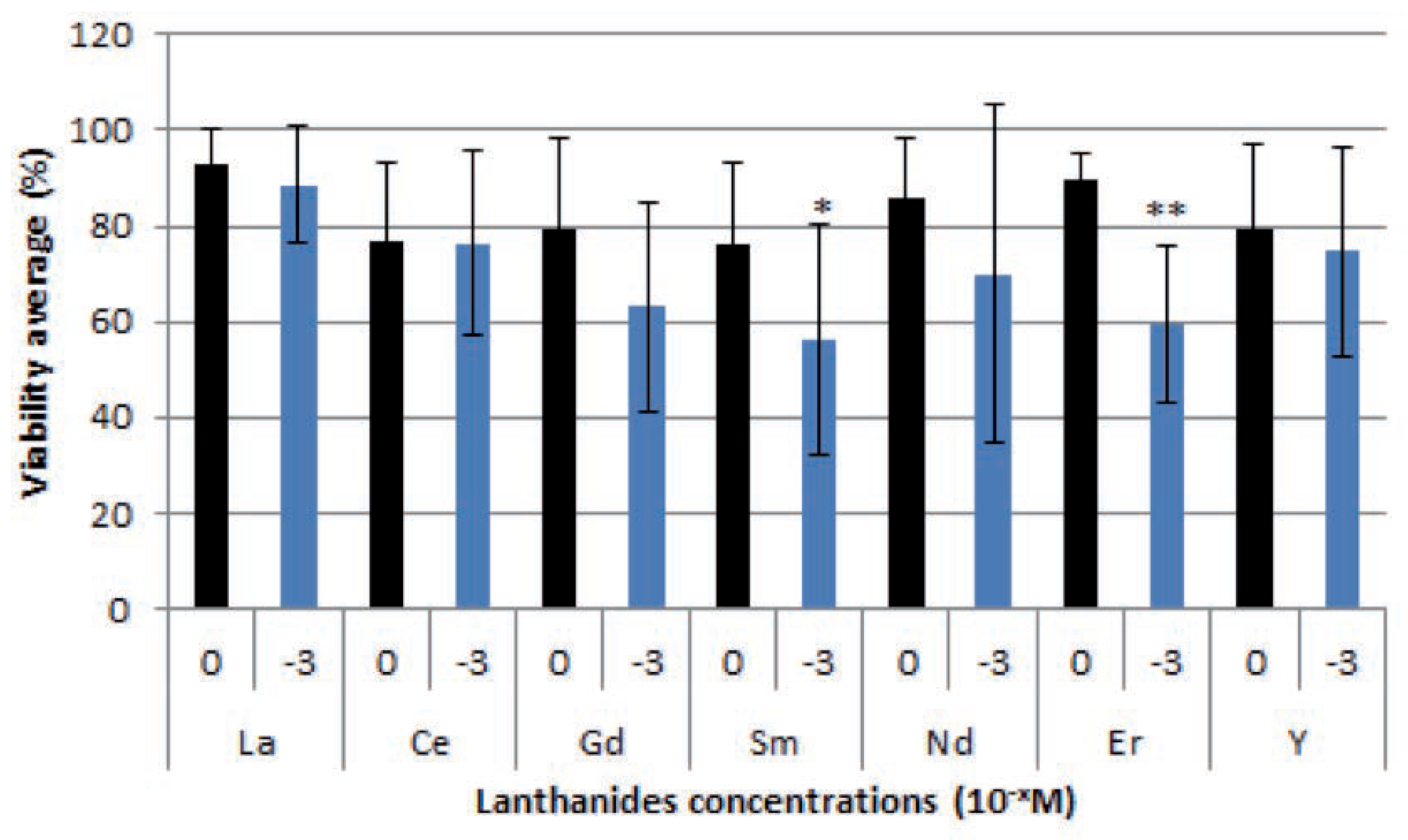Cellular Effects of Lanthanides on Mytilus edulis †
Introduction
Materials and Methods
Hemolymph collection and cellularity
Lanthanides exposition
Statistical analysis
Results
Discussion and Conclusions
References
- Gonzalez, V.; Vignati, D.A.L.; Leyval, C.; Giamberini, L. Environmental fate and ecotoxicity of lanthanides: Are they a uniform group beyond chemistry? Environ Int 2014, 71, 148–57. [Google Scholar]
- Fricker, S.P. The therapeutic application of lanthanides. Chem Soc Rev 2006, 35, 524–33. [Google Scholar]
- Paasz, A.; Czekaj, P. Toxicological and cytophysiological aspects of lanthanides action. Acta Biochim Pol 2000, 47, 1107–14. [Google Scholar]
- Oliveira, M.S.; Duarte, I.M.; Paiva, A.V.; Yunes, S.N.; Almeida, C.E.; Mattos, R.C.; Sarcinelli, P.N. The role of chemical interactions between thorium, cerium, and lanthanum in lymphocyte toxicity. Arch Environ Occup H 2014, 69, 40–5. [Google Scholar]
- Ratre, P.; Kumar, D. Spectrophotometric determination of trace amounts of samarium in environmental samples. Am Int J Res Formal Appl Nat Sci 2013, 3, 110–8. [Google Scholar]
- Bentlin, F.R.S.; Pozebon, D. Direct determination of lanthanides in environmental samples using ultrasonic nebulization and ICP OES. J Braz Chem Soc 2010, 21, 627–34. [Google Scholar]
- Kulaksiz, S.; Bau, M. Rare earth elements in the Rhine River, Germany: first case of anthropogenic lanthanum as a dissolved microcontaminant in the hydrosphere. Environ Int 2011, 37, 973–9. [Google Scholar]

©Copyright P. Pharand et al., 2015 Licensee PAGEPress, Italy. This work is licensed under a Creative Commons Attribution NonCommercial 3.0 License (CC BY-NC 3.0).
Share and Cite
Pharand, P.; Brousseau-Fournier, C.; Côté, C.; Gagné, F.; Fournier, M.; Brousseau, P. Cellular Effects of Lanthanides on Mytilus edulis. J. Xenobiot. 2015, 5, 5781. https://doi.org/10.4081/xeno.2015.5781
Pharand P, Brousseau-Fournier C, Côté C, Gagné F, Fournier M, Brousseau P. Cellular Effects of Lanthanides on Mytilus edulis. Journal of Xenobiotics. 2015; 5(2):5781. https://doi.org/10.4081/xeno.2015.5781
Chicago/Turabian StylePharand, P., C. Brousseau-Fournier, C. Côté, F. Gagné, M. Fournier, and P. Brousseau. 2015. "Cellular Effects of Lanthanides on Mytilus edulis" Journal of Xenobiotics 5, no. 2: 5781. https://doi.org/10.4081/xeno.2015.5781
APA StylePharand, P., Brousseau-Fournier, C., Côté, C., Gagné, F., Fournier, M., & Brousseau, P. (2015). Cellular Effects of Lanthanides on Mytilus edulis. Journal of Xenobiotics, 5(2), 5781. https://doi.org/10.4081/xeno.2015.5781



